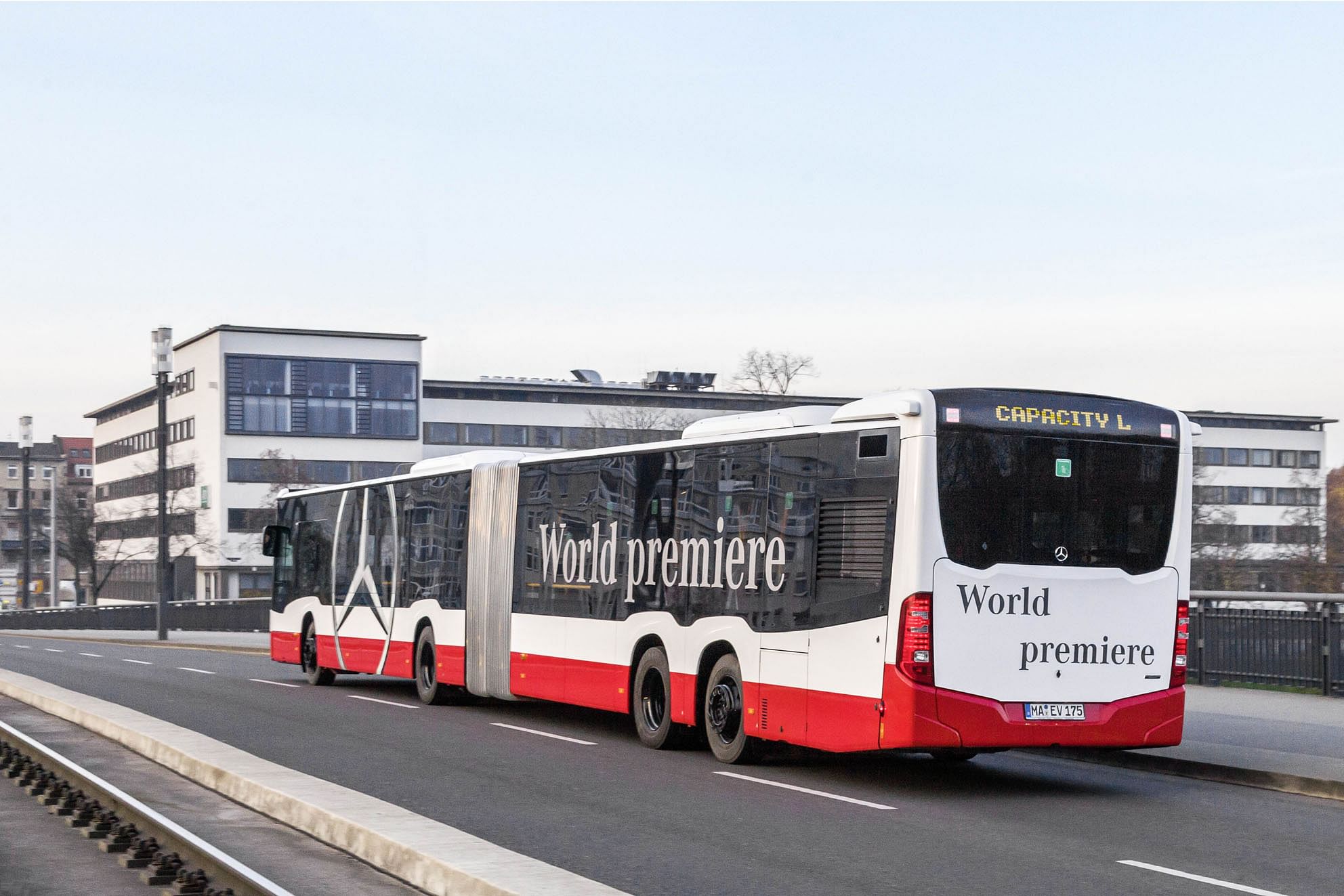Mercedes-Benz CapaCity L high-capacity articulated bus can transport 191 passengers!
It is an imposing 21 metres long, around three metres longer than conventional articulated buses
It is an imposing 21 metres long, around three metres longer than conventional articulated buses, and provides space for up to 191 passengers as standard. It consumes well below 0.5 l/100 km per passenger and has only minimal emissions. Mercedes-Benz’s latest CapaCity L high-capacity articulated bus makes an important contribution towards counteracting the transport problems in inner cities.
The busmaker says the CapaCity L is the answer to current transport problems, since frequently used bus lines are reaching their limits as passenger numbers continue to rise. With the CapaCity L, transport operators can carry far more passengers with the same number of buses.
Whether new shopping centres, residential areas or industrial estates, they can all be served quickly and cost-effectively with the CapaCity L without the need for high investment – all the high-capacity bus needs is a road. The CapaCity L is therefore ideally suitable for BRT (Bus Rapid Transit) systems.

"The CapaCity L makes an important contribution towards reducing the volume of traffic in inner cities. It is the longest European bus with just one articulated turntable. Plus it is environmentally friendly – no other bus with a diesel engine has lowerCO₂ emissions per passenger," explains Hartmut Schick, head of Daimler Buses. The CapaCity L is exactly what the transport operators want. Ulrike Riedel, member of the executive board responsible for human resources and operations at Hochbahn, says: "We are pleased about increasing passenger numbers. At peak times, we cannot further increase the frequency at which our buses are running in many cases, so high-capacity buses such as the new CapaCity L are a very appealing option for us."
Hamburger Hochbahn will this year become the first transport operator to trial the new Mercedes-Benz CapaCity L under real operating conditions. For this purpose, the high-capacity bus is being used on Metrobus Line 5, from the city centre to the university quarter in the north west of the city. It is Western Europe's busiest bus line.
No elaborate conversions are necessary for the CapaCity L: despite its imposing length, the high-capacity bus is surprisingly manoeuvrable and meets the requirements of the German road traffic registration ordinance. It only requires a certificate of exemption on account of its length; after all, it is much longer than 18.75 metres, which is the maximum permissible length for vehicle combinations.
The new regular-service giant is based on the proven Mercedes-Benz Citaro G articulated bus and therefore easy for drivers and workshops to familiarise themselves with the CapaCity L. The key difference is that the front section and rear section have each been lengthened by one segment for the CapaCity L. Furthermore, a steered fourth axle raises the permissible GVW to 32 t. Thanks to a clever automatic control system called ASA (Additional Steering Axle), the axle also ensures that the high-capacity bus is surprisingly manoeuvrable.
Not only is the CapaCity L large, it is also clean. Its engine, a six-cylinder in-line unit with a displacement of 10.7 litres compliant with the Euro VI emissions standard, has an output of 265 kW (360 hp) or 290 kW (394 hp). Optimum consumption is not only the name of the game for the engine and the automatic transmission adapted for the CapaCity L, but also for all the ancillary components.
Consequently, when the CapaCity L is operated on a usual regular-service route with a full complement of passengers on board, it consumes well below 0.5 l/100 km per passenger. This figure makes it the most economical urban bus with diesel drive and is well below that of a passenger car. The fuel consumption equates to CO₂ emissions below 13.3 g/km per passenger – a sensationally low figure.
Articulated Turntable Controller ATC
Another ingenious feature is the unique ATC (Articulated Turntable Controller) system on the CapaCity L, newly developed by Mercedes-Benz. ATC controls the hydraulic damping of the articulated turntable quickly and on demand, ensuring optimum steering characteristics during normal operation. If any instability is encountered – on a slippery road surface, for example – ATC stabilises the articulated bus within the bounds of physical possibility. The ATC is thus the only system of its type to achieve anything like the effect of an electronic stability control system (ESP). This means a new level of safety for articulated buses.
During development of the CapaCity L, the engineers benefitted from their extensive experience with the Citaro, the world's most successful urban bus. Despite this, the new CapaCity L also had to pass intensive functional and practical tests, such as extensive winter testing in icy temperatures in Scandinavia. A further test will come in the shape of the imminent customer trial under real regular-service operating conditions at Hamburger Hochbahn.
RELATED ARTICLES
Autoliv Plans JV for Advanced Safety Electronics With China’s HSAE
The new joint venture, which is to be located strategically near Shanghai and close to several existing Autoliv sites in...
JLR to Restart Production Over a Month After September Hacking
Manufacturing operations at the Tata Group-owned British luxury car and SUV manufacturer were shut down following a cybe...
BYD UK Sales Jump 880% in September to 11,271 units
Sales record sets the UK apart as the largest international market for BYD outside of China for the first time. The Seal...






 By Autocar Professional Bureau
By Autocar Professional Bureau
 02 Dec 2014
02 Dec 2014
 13503 Views
13503 Views





 Ajit Dalvi
Ajit Dalvi




